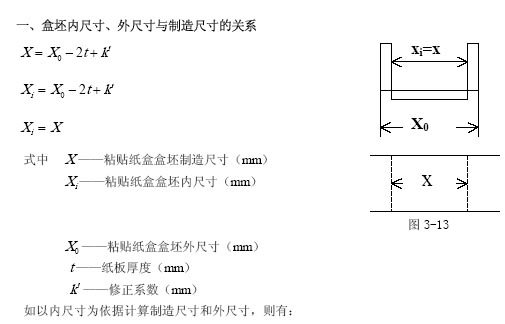Section 11 Paste Carton Size Design



Section 12 Production Process of Carton
This section describes the main process flow and main processing technology of the mechanism tray.
First, the process according to the different raw materials used, the carton production process is also slightly different.
1. Flat sheet cardboard box making process
2. Small color corrugated board box making process,
3. Main factors affecting carton quality
(1) Structural design;
(2) raw materials;
(3) printing;
(4) Die-cutting.
Therefore, printing and die cutting are two key processes in the box making process. The fineness of printing greatly influences the decorating effect of the carton, that is, affects its promotion function: The quality of the die cutting greatly influences the structure of the carton (appearance, precision, fit, fineness of the process, etc.).
Second, the main process
1. Cutting (also known as cutting)
That is, raw materials are cut to a certain size of paper blank (fabrication unit) according to the size and size of the blank.
The following aspects should be noted when cutting:
(1) Layout size Generally, the billet is cut into full open, open, open, eight open, etc. Otherwise, the use of residual materials should be determined to avoid unnecessary waste.
When determining the size of the paper blank layout, note that:
1 The size of existing equipment specifications should make full use of the existing equipment's production capacity:
2 The production must be economical, make full use of raw materials, and be easy to operate.
(2) Tailoring: The unfolding outline of the carton is uneven. Arrange reasonably to save materials.
(3) Paperboard orientation: It should be perpendicular to the main indentation line of the carton to ensure the quality of the entire carton.
(4) The front and back of the cardboard
(5) Relieving head: It is necessary to leave a certain allowance around the outline of the box blank. Generally, it is set to 10mm according to the layout, and the minimum must not be less than 5mm.
2. Printing:
3. Surface processing:
After the board is printed, it is generally required to perform a surface treatment after printing or punching in order to improve the surface abrasion resistance, oil resistance, water resistance and decorativeness.
Commonly used surface processing methods include: coating, polishing, hot stamping, embossing and so on.
For details on this section, see Supporting Materials.
4. Die cutting:
For details on this section, see Supporting Materials.
5. Blanking:
After die-cutting, the box blank (also called paper core) should be taken out of the entire paper blank, removing all the waste paper edges except the outline of the blank box, and the free space in the middle of the box blank, such as the waste in the handle hole. Therefore, it is also called tearing, knocking, scavenging, etc. There are two kinds of processing methods: automatic blanking and manual blanking.
6. Make box:
The main content is folding, bonding or nailing plywood.
Third, the surface processing technology
Fourth, die cutting technology